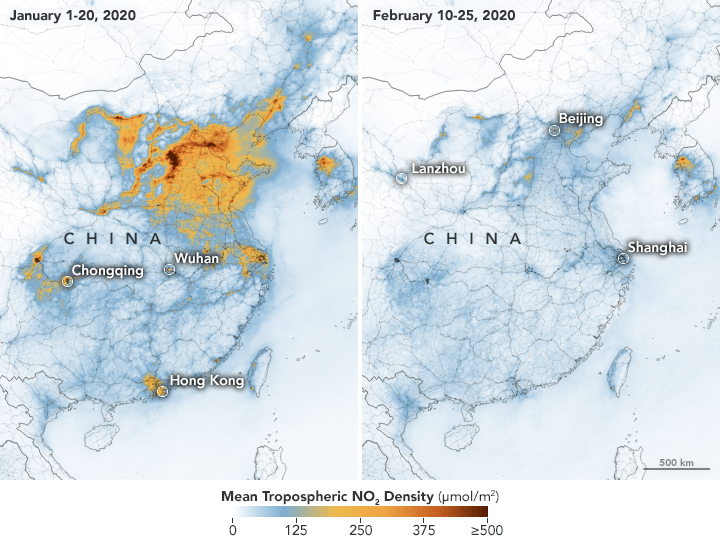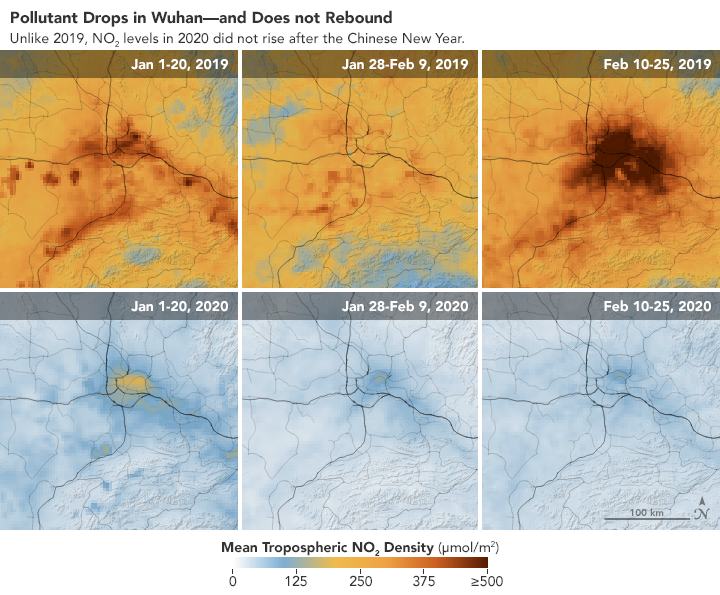New satellite images released by NASA and the European Space Agency show a dramatic decrease in the amount of pollution over China, as the country takes measures to limit the spread of novel coronavirus.

According to NASA, pollution monitoring satellites have detected “significant decreases” in the level of nitrogen dioxide hanging over the country, a change the agency says is “at least partly related to the economic slowdown following the outbreak of coronavirus.”
The disease caused by the virus has been formally named COVID-19. It was first detected in China late last year. In the months since, it has infected more than 87,000 people globally and has killed nearly 3,000.
The virus is believed to have originated in China’s Hubei province, in the city of Wuhan. Shortly after its discovery, Wuhan and several other cities were placed under strict quarantine in an effort to limit the spread of the virus.
Nearly 50 million people were under the lockdown, which saw mass transportation cancellations and the shuttering of schools, factories and offices.

NASA scientists said the reduction in NO2 pollution was first apparent near Wuhan but eventually spread across the country.
According to the U.S. Environmental Protection Agency, NO2 is a group of highly reactive gasses that form primarily from emissions from vehicles, power plants and other equipment.

Get weekly health news
Scientists compared NO2 levels in the first two months of 2019 to the same period this year.
Maps released by the agency show NO2 levels from across China from before the quarantine went into effect, and during.
“This is the first time I have seen such a dramatic drop-off over such a wide area for a specific event,” Fei Liu, an air quality researcher at NASA’s Goddard Flight Centre, said in a statement.
According to Liu, during the 2008 recession, scientists reported a drop in NO2 levels over “several countries” but said the decrease was more gradual.
READ MORE: Mapping out the coronavirus — Here’s which countries have reported cases so far
Scientists also observed a significant reduction in pollution levels around Beijing during the 2008 Olympics but said levels rose again after the games ended.
This year’s drop in NO2 levels also coincided with Lunar New Year celebrations in China and much of Asia.

According to NASA, past observations have shown that air pollution tends to decrease during this period because businesses and factories close to celebrate the festival.
“There is always this general slowdown around this time of year,” Barry Lefer, an air quality scientist at NASA, said in a statement.
However, NO2 levels tend to rise again once the celebrations are over.
Liu said this year, though, scientists have not seen a rebound in pollution levels after the holiday.
And NASA researchers believe the decrease is “more than a holiday effect or weather-related variation.”
This year, scientists found NO2 values in eastern and central China were “significantly lower” — 10 per cent to 30 per cent lower — than what is normally observed for this time period.
“This year, the reduction rate is more significant than the past years and it has lasted longer,” Liu said. “I am not surprised because many cities nationwide have taken measures to minimize spread of the virus.”









Comments